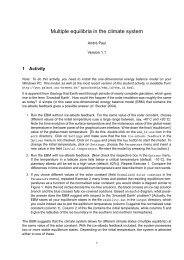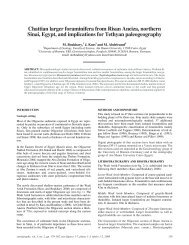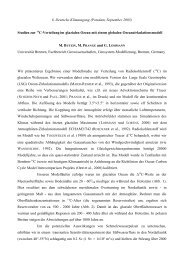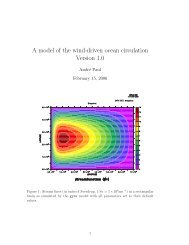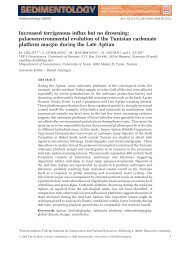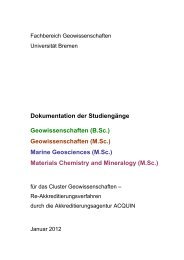Forschung im HLRN-Verbund 2011
Forschung im HLRN-Verbund 2011
Forschung im HLRN-Verbund 2011
- Keine Tags gefunden...
Erfolgreiche ePaper selbst erstellen
Machen Sie aus Ihren PDF Publikationen ein blätterbares Flipbook mit unserer einzigartigen Google optimierten e-Paper Software.
B b u eB0 b c ed D+ddb c B0 D+d d u B0 b c uD+d d d167Figure 1: Left plot: examples of leptonic (B − → τ −¯ν τ ), semi-leptonic ( ¯B 0 → D + e −¯ν e ), and non-leptonic( ¯B 0 → 5D + π − ) decays of B mesons. Right plot: More realistic representation of a non-leptonic decay.specifically it concentrates on a precise computationof the b-quark mass and the so called B-mesons decay constants which are the single parametersparametrizing bound-state effects in leptonicdecays.One of the reasons why HQET is a very <strong>im</strong>portanttool is that at present, due to computer l<strong>im</strong>itations,it is not possible, to work directly with theheaviest quarks (as the b-quark) propagating onthe s<strong>im</strong>ulated lattice. We have devised a method,to overcome this difficulty which makes use of particularratios of physical quantities computed atslightly different values of relativistic heavy quarkmasses. This novel approach to B-physics removescompletely all the uncertainties on the staticpoint results which are needed in standard HeavyQuark Effective Theory (HQET) inspired methods.We plan to compute the b-quark mass and thepseudoscalar decay constants f B and f Bs withhigh precision. We also plan to start an investigationfor the determination of the masses of baryonscontaining at least one heavy quark. When oneperforms QCD computation on a space-t<strong>im</strong>e latticeone has to specify in what way the QCD interactionis modified by the presence of a discrete lattice.There are several ways to define QCD on alattice and they all differ by the so-called discretizationerrors or lattice spacing effects. If we have anhypercubic lattice with spacing a discretization errorsare in principle at least of O(a). If one choosesappropriately the way to describe QCD on a latticeone can try to reduce these errors to be smaller,e.asg. of O(a 2 ). This is very <strong>im</strong>portant since therate with what we reach the continuum QCD theory,i.e. sending a → 0, is much faster. This <strong>im</strong>pliesthat at finite a the results do not differ substantiallyto the continuum QCD results giving us confidencewhen performing the extrapolation to a = 0.We have used a way to describe QCD on an hypercubiclattice called Wilson twisted mass. Thisparticular lattice theory has the advantage of ensuringand automatic removal of all the leadingO(a) lattice spacing corrections to all the physicalquantities at the price of a single non-perturbativetuning of one of the parameters present in the theory.With our approach we have already publishedon JHEP results obtained with a feasibility studyand they are very encouraging [1]. They comparenicely with the state of art calculations today availablein the literature as well as with Particle DataGroup (PDG) numbers.The precision of our first results published onJHEP is still not comparable with recent theoreticaland exper<strong>im</strong>ental determinations. To fill thisgap in this project we propose to <strong>im</strong>prove in severaltechnical aspects of our computation in orderto be competitive with the best exper<strong>im</strong>ental determinationsand to contribute in the search for NewPhysics beyond the SM.More Information1. B. Blossier et al. [ETM Collaboration]: “A proposalfor B-physics on current lattices, JHEP1004 (2010) 049 [arXiv:0909.3187 [hep-lat]].FundingGerman Research Foundation (DFG)Physik




